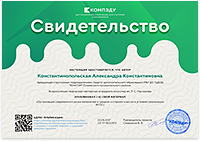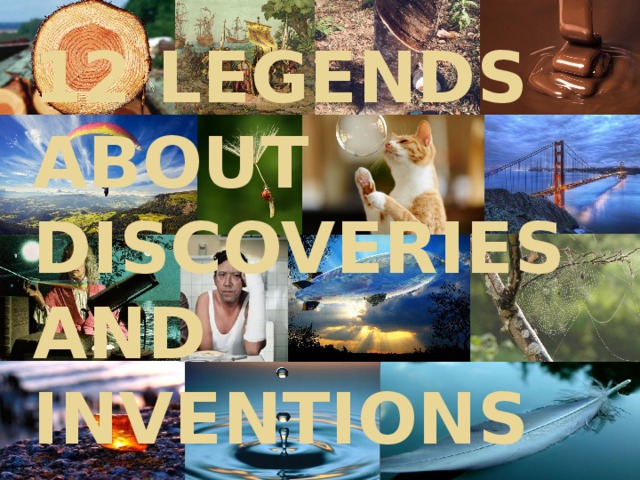
12 LEGENDS ABOUT DISCOVERIES AND INVENTIONS
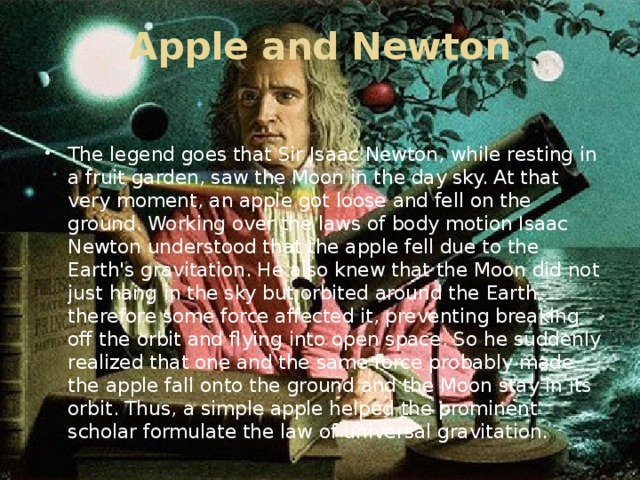
Apple and Newton
- The legend goes that Sir Isaac Newton, while resting in a fruit garden, saw the Moon in the day sky. At that very moment, an apple got loose and fell on the ground. Working over the laws of body motion Isaac Newton understood that the apple fell due to the Earth's gravitation. He also knew that the Moon did not just hang in the sky but orbited around the Earth, therefore some force affected it, preventing breaking off the orbit and flying into open space. So he suddenly realized that one and the same force probably made the apple fall onto the ground and the Moon stay in its orbit. Thus, a simple apple helped the prominent scholar formulate the law of universal gravitation.
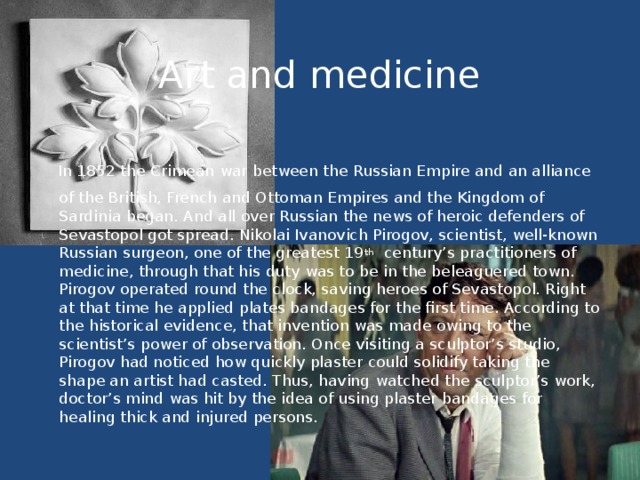
Art and medicine
In 1852 the Crimean war between the Russian Empire and an alliance of the British, French and Ottoman Empires and the Kingdom of Sardinia began. And all over Russian the news of heroic defenders of Sevastopol got spread. Nikolai Ivanovich Pirogov, scientist, well-known Russian surgeon, one of the greatest 19 th century’s practitioners of medicine, through that his duty was to be in the beleaguered town. Pirogov operated round the clock, saving heroes of Sevastopol. Right at that time he applied plates bandages for the first time. According to the historical evidence, that invention was made owing to the scientist’s power of observation. Once visiting a sculptor’s studio, Pirogov had noticed how quickly plaster could solidify taking the shape an artist had casted. Thus, having watched the sculptor’s work, doctor’s mind was hit by the idea of using plaster bandages for healing thick and injured persons.
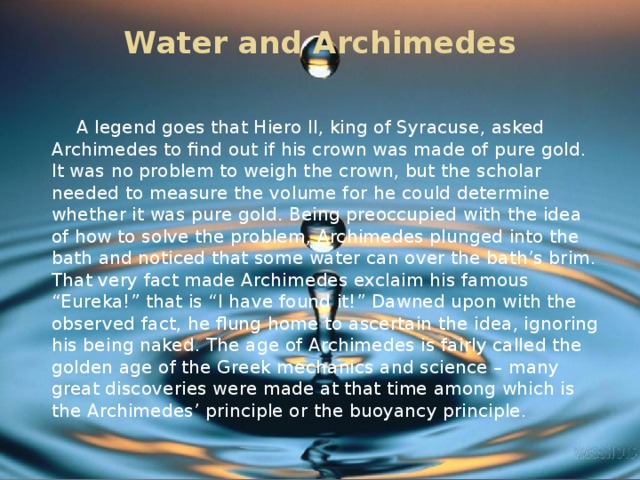
Water and Archimedes
A legend goes that Hiero II, king of Syracuse, asked Archimedes to find out if his crown was made of pure gold. It was no problem to weigh the crown, but the scholar needed to measure the volume for he could determine whether it was pure gold. Being preoccupied with the idea of how to solve the problem, Archimedes plunged into the bath and noticed that some water can over the bath’s brim. That very fact made Archimedes exclaim his famous “Eureka!” that is “I have found it!” Dawned upon with the observed fact, he flung home to ascertain the idea, ignoring his being naked. The age of Archimedes is fairly called the golden age of the Greek mechanics and science – many great discoveries were made at that time among which is the Archimedes’ principle or the buoyancy principle.
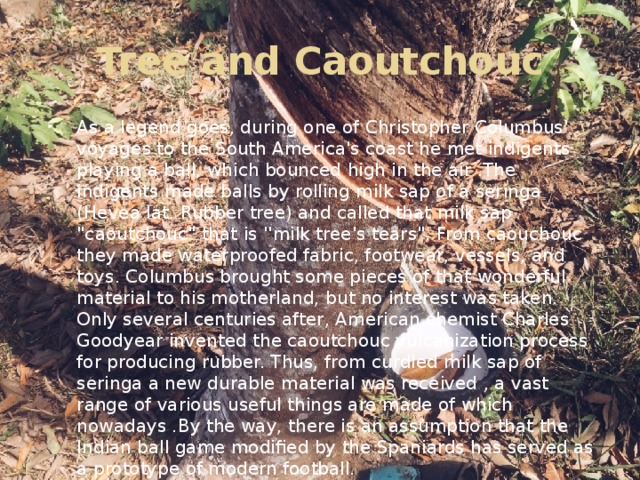
Tree and Caoutchouc
- As a legend goes, during one of Christopher Columbus' voyages to the South America's coast he met indigents playing a ball, which bounced high in the air .The indigents made balls by rolling milk sap of a seringa (Hevea lat. Rubber tree) and called that milk sap "caoutchouc" that is ''milk tree's tears". From caouchouc they made waterproofed fabric, footwear, vessels, and toys. Columbus brought some pieces of that wonderful material to his motherland, but no interest was taken. Only several centuries after, American chemist Charles Goodyear invented the caoutchouc vulcanization process for producing rubber. Thus, from curdled milk sap of seringa a new durable material was received , a vast range of various useful things are made of which nowadays .By the way, there is an assumption that the Indian ball game modified by the Spaniards has served as a prototype of modern football.
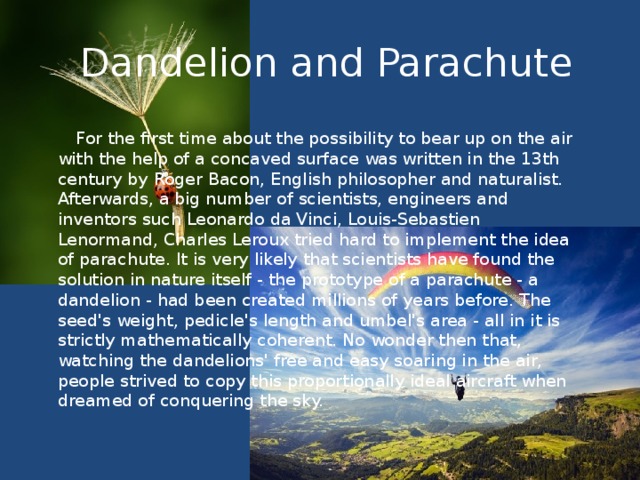
Dandelion and Parachute
For the first time about the possibility to bear up on the air with the help of a concaved surface was written in the 13th century by Roger Bacon, English philosopher and naturalist. Afterwards, a big number of scientists, engineers and inventors such Leonardo da Vinci, Louis-Sebastien Lenormand, Charles Leroux tried hard to implement the idea of parachute. It is very likely that scientists have found the solution in nature itself - the prototype of a parachute - a dandelion - had been created millions of years before. The seed's weight, pedicle's length and umbel's area - all in it is strictly mathematically coherent. No wonder then that, watching the dandelions' free and easy soaring in the air, people strived to copy this proportionally ideal aircraft when dreamed of conquering the sky.
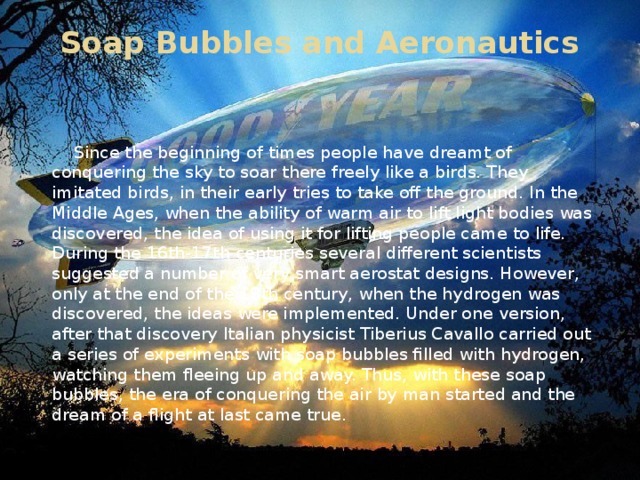
Soap Bubbles and Aeronautics
Since the beginning of times people have dreamt of conquering the sky to soar there freely like a birds. They imitated birds, in their early tries to take off the ground. In the Middle Ages, when the ability of warm air to lift light bodies was discovered, the idea of using it for lifting people came to life. During the 16th-17th centuries several different scientists suggested a number of very smart aerostat designs. However, only at the end of the 18th century, when the hydrogen was discovered, the ideas were implemented. Under one version, after that discovery Italian physicist Tiberius Cavallo carried out a series of experiments with soap bubbles filled with hydrogen, watching them fleeing up and away. Thus, with these soap bubbles, the era of conquering the air by man started and the dream of a flight at last came true.
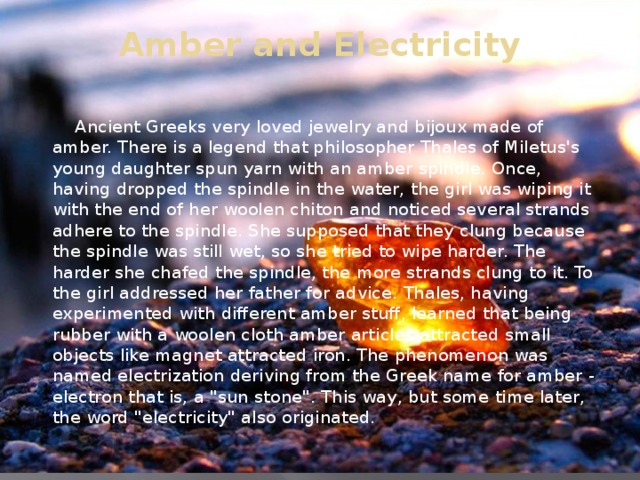
Amber and Electricity
Ancient Greeks very loved jewelry and bijoux made of amber. There is a legend that philosopher Thales of Miletus's young daughter spun yarn with an amber spindle. Once, having dropped the spindle in the water, the girl was wiping it with the end of her woolen chiton and noticed several strands adhere to the spindle. She supposed that they clung because the spindle was still wet, so she tried to wipe harder. The harder she chafed the spindle, the more strands clung to it. To the girl addressed her father for advice. Thales, having experimented with different amber stuff, learned that being rubber with a woolen cloth amber articles attracted small objects like magnet attracted iron. The phenomenon was named electrization deriving from the Greek name for amber - electron that is, a "sun stone". This way, but some time later, the word "electricity" also originated.
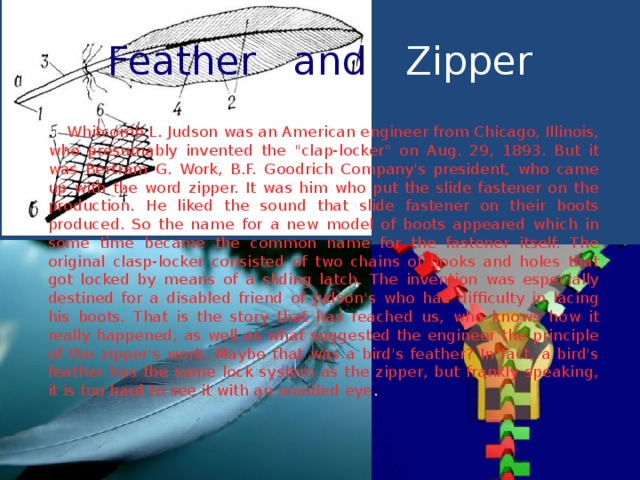
Feather and Zipper
Whitcomb L. Judson was an American engineer from Chicago, Illinois, who presumably invented the "clap-locker" on Aug. 29, 1893. But it was Bertram G. Work, B.F. Goodrich Company's president, who came up with the word zipper. It was him who put the slide fastener on the production. He liked the sound that slide fastener on their boots produced. So the name for a new model of boots appeared which in some time became the common name for the fastener itself. The original clasp-locker consisted of two chains of hooks and holes that got locked by means of a sliding latch. The invention was especially destined for a disabled friend of Judson's who had difficulty in lacing his boots. That is the story that has reached us, who knows how it really happened, as well as what suggested the engineer the principle of the zipper's work. Maybe that was a bird's feather? In fact, a bird's feather has the same lock system as the zipper, but frankly speaking, it is too hard to see it with an unaided eye .
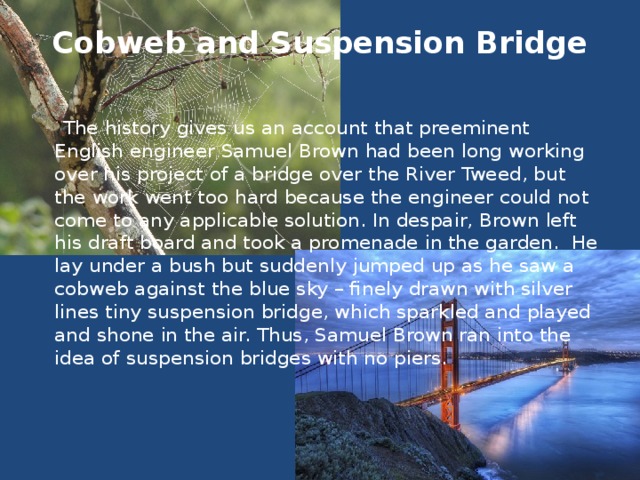
Cobweb and Suspension Bridge
The history gives us an account that preeminent English engineer Samuel Brown had been long working over his project of a bridge over the River Tweed, but the work went too hard because the engineer could not come to any applicable solution. In despair, Brown left his draft board and took a promenade in the garden. He lay under a bush but suddenly jumped up as he saw a cobweb against the blue sky – finely drawn with silver lines tiny suspension bridge, which sparkled and played and shone in the air. Thus, Samuel Brown ran into the idea of suspension bridges with no piers.
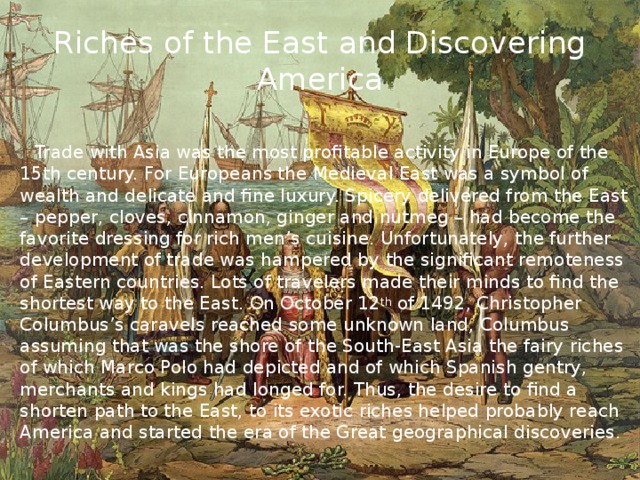
Riches of the East and Discovering America
Trade with Asia was the most profitable activity in Europe of the 15th century. For Europeans the Medieval East was a symbol of wealth and delicate and fine luxury. Spicery delivered from the East – pepper, cloves, cinnamon, ginger and nutmeg – had become the favorite dressing for rich men’s cuisine. Unfortunately, the further development of trade was hampered by the significant remoteness of Eastern countries. Lots of travelers made their minds to find the shortest way to the East. On October 12 th of 1492, Christopher Columbus’s caravels reached some unknown land, Columbus assuming that was the shore of the South-East Asia the fairy riches of which Marco Polo had depicted and of which Spanish gentry, merchants and kings had longed for. Thus, the desire to find a shorten path to the East, to its exotic riches helped probably reach America and started the era of the Great geographical discoveries.
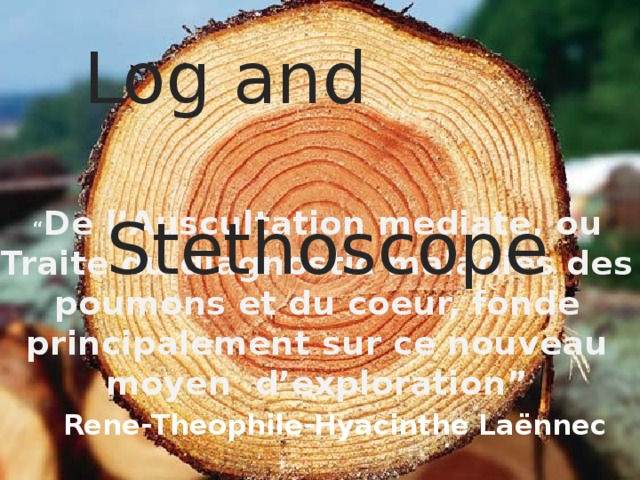
Log and Stethoscope
“ De l’Auscultation mediate, ou Traite du diagnostic maladies des poumons et du coeur, fonde principalement sur ce nouveau moyen d’exploration” Rene-Theophile-Hyacinthe Laёnnec
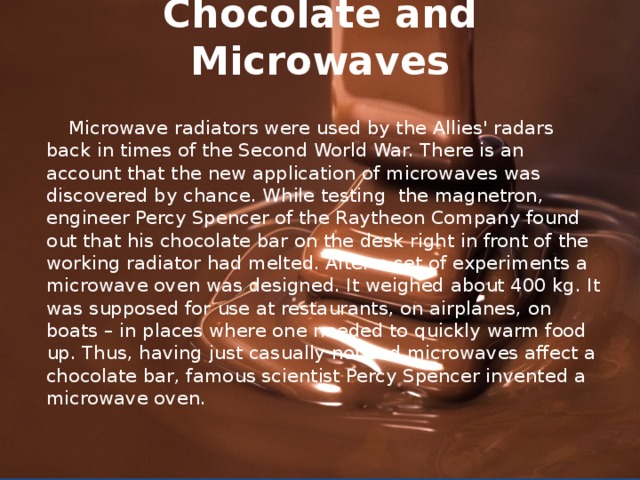
Chocolate and Microwaves
Microwave radiators were used by the Allies' radars back in times of the Second World War. There is an account that the new application of microwaves was discovered by chance. While testing the magnetron, engineer Percy Spencer of the Raytheon Company found out that his chocolate bar on the desk right in front of the working radiator had melted. After a set of experiments a microwave oven was designed. It weighed about 400 kg. It was supposed for use at restaurants, on airplanes, on boats – in places where one needed to quickly warm food up. Thus, having just casually noticed microwaves affect a chocolate bar, famous scientist Percy Spencer invented a microwave oven.

